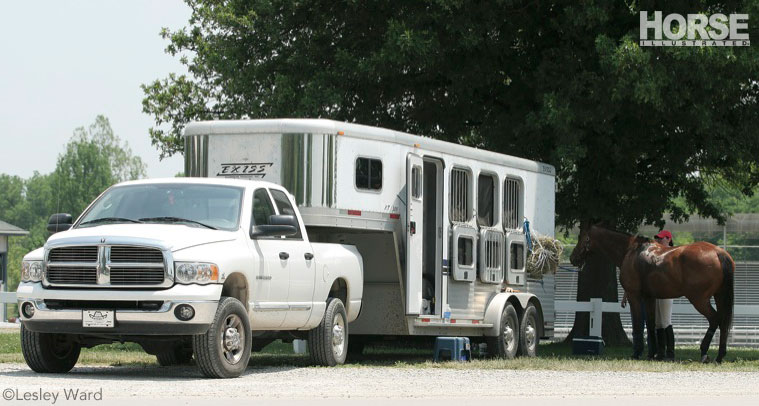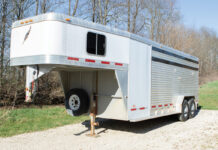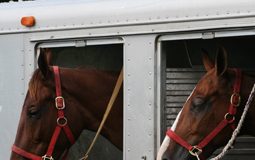You’re towing down a high-crowned, two-lane country highway at a safe speed. Your trailer and truck are in perfect working order and your horses are calm and snug in the trailer behind you. You notice a semi-trailer truck headed toward you seems to be traveling much faster than the other vehicles that have passed. As the massive truck flies by, the sudden change in air pressure causes your fully loaded trailer to start swaying. You struggle to hold the wheel straight as the trailer begins fishtailing. The trailer wheel drops off the side of the road and before you can react again, the trailer tilts into the ditch …

Although no one plans to have accidents, they happen. The key to weathering them, say crisis-management experts, is planning in advance exactly what you will do if an accident occurs.
Taking Control
The idea is to be proactive rather than reactive, says Dr. Jim Hamilton of Southern Pines Equine Associates in Southern Pines, N.C. Dr. Hamilton’s practice includes Olympic-caliber horses, and he has helped North Carolina officials add information about animals to its statewide natural disaster planning program. Hamilton has also helped the state develop a continuing education unit on emergency management of animals. This program is included in the state’s annual training for emergency medical technicians and other rescue personnel.
Top athletes often use the psychological technique of “visualization” to help them mentally plan and execute a winning strategy. They close their eyes, break their task down into the smallest possible steps, then mentally watch themselves going through each of those steps. When the time comes to actually perform, they go out with confidence because, in a sense, they’ve already been there and done that. They can focus and concentrate. Surprises are less likely because they have already thought through every possible scenario.
“When people get panicky, they forget a lot of things they’ve learned,” says Dr. Hamilton. “Accept that fact and take steps to help yourself think clearly in emergency situations.” Even in accident situations where no one is physically hurt, the ability to be ingenious and resourceful can be severely hampered by anxiety. The best planning you can do, he says, is to sit down and think of every possible thing that might happen to your horse on the road. Then think about how many different ways you might face each emergency and what tools and supplies you would need. Finally, imagine yourself actually taking the necessary actions to resolve the problem.
Planning Ahead
A good first-aid kit is one of your most essential supplies. Use your veterinarian’s experience and knowledge to help you stock appropriate first-aid supplies. Discuss his or her recommendations about carrying and administering prescription drugs for things like pain relief or sedation. This can be a very personal decision for both owners and veterinarians. Be honest about your ability and comfort level. While one horse owner might feel quite confident and competent about giving a horse an injection, another might feel anxious about it under the best of circumstances. Carrying and anti-inflammatory paste to use in an emergency will not do much good if you cannot administer your horse’s paste wormer at home under less stressful conditions.
Among the medical problems you should plan for are colic, heat exhaustion, dehydration, superficial injuries, deep wounds and broken limbs If you have never taken a first-aid course, now is the time to do so. Many first-aid techniques, such as applying pressure to wounds to stop bleeding or applying ice packs to sprains, are the same for horses as they are for people. Work with your vet and consult veterinary guides to learn how to adapt standard first-aid techniques to horse anatomy if you do not know how to do that already.
One of the most common problems Dr. Hamilton sees is people who trailer their horses without adequate water supplies. They will use the excuse that they are not traveling very far, that their horses will not drink while traveling anyway or that there will be ample water at their destination. That is a primary example of poor emergency planning, he says.
Imagine that a mechanical breakdown has stranded you alongside a busy interstate highway. It is a very hot day and you have no water with you. The tow truck says he’ll be there in an hour but doesn’t actually arrive for almost 90 minutes. After assessing the situation, he says he needs to return to the service station for a part to fix your engine. Another 90 minutes go by. Your horses are now hot, thirsty and possibly becoming dehydrated. You need fresh water for them to drink to stave off colic and, as time goes on, you realize that you also need it to help cool them down.
If you trailer two horses, says Hamilton, plan to carry about 5 gallons per horse for drinking, plus another 5 to 10 gallons to cool them if the heat becomes too much. Just in case, he also likes to see about 5 gallons of water available to cleanse major wounds. That’s a total of 20 to 25 gallons of water. If you will be on the road more than three or four hours, this amount should be increased. People who plan ahead use special molded plastic containers that fit into the nose of their trailers, strap plastic gerry cans into the trailer’s wheel wells or improvise with various types of plastic coolers. Regardless of how they do it, they are prepared with enough water to meet the demands of several potential emergencies.
Another example of advance planning is finding and preparing suitable splinting materials to use in the case of a broken limb. Dr. Hamilton likes to use a splint-length of PVC pipe to stabilize and support a leg. However, he notes, these must be custom-cut to fit a particular animal. Get help from your vet to choose a pipe diameter and length suitable for each animal, then label them with the animal’s name. If you don’t want to carry a PVC splint, says Dr. Hamilton, think ahead about what supplies are on your trailer and how you could improvise with them to make a splint.
Many people now use fleece-lined shipping boots instead of standing bandages, but the well-prepared traveler should still carry a set or two of those stretchy, old-fashioned knit bandages for wrapping and holding splints or bandaging materials. Extra towels should be on hand as well, since they can be used to clean wounds or apply pressure to stop bleeding.
Step By Step
Because it can be hard to think clearly in emergencies, Dr. Hamilton advises horse owners to carry a checklist in their glove compartment to pull out and follow. Here are the steps he recommends:
- Be calm. Assess your physical condition and that of any passengers before attending to the horses. Emergency personnel often report that their most difficult job at the scene of a trailering accident is calming a hysterical owner. Try to relax, focus and think as clearly as possible.
- Determine if you need outside help and how to get it. Do you need to call 911 to get emergency medical attention or summon the police? Do you need to call a service station or a tow truck? Having a list of phone numbers with you in your vehicle can help you stay calm and take action decisively. A cellular phone (fully charged and with roaming capability for the areas you are traveling through) or a citizen’s band radio can make a critical time difference in a medical emergency.
- Assess the condition of the horses and their needs. Do the horses have injuries or other immediate medical needs? Is a horse bleeding profusely? Is he breathing rapidly and shallowly, have a weak pulse or slow capillary-refill time? Gather as much specific information as possible to relay to the nearest veterinarian. The vet’s biggest challenge when a phone call comes in about a trailering accident is trying to surmise what the horse is doing and what is medically needed. The clearer the owner can be, the more accurate the veterinarian’s phone recommendations can be. If the emergency is a mechanical one, the horses’ needs may simply be for food and water while waiting for help to arrive.
- Unload the horses only if you are in a quiet, absolutely safe area with enough personnel to manage the animals. Relaxing the animals and stabilizing any injuries is often the first goal after an accident. However, Dr. Hamilton cautions, never unload the horses along the side of a high-speed interstate highway. That is a recipe for disaster. If at all possible, pull off the highway and find a quiet area to unload. Otherwise, keep the horses in the trailer until an alternate tow vehicle or other help arrives.
- Determine what you can do and accept what you cannot do until further help arrives. In a true emergency, your ability to affect the situation may be severely limited. For example, you may not be able to do much more with a heavily bleeding gash than to try to calm the horse while you apply steady pressure until the vet arrives.
If a horse is acting colicky, you can encourage the animal to drink until the vet arrives to fully assess the situation. Figure out what is possible and take those actions while you wait for a veterinarian or other emergency personnel to come. However, avoid overreacting and making the situation worse by trying to do more than you are equipped to handle.
Second in Command
Another critical contingency to plan for is what will happen if you are unable to act at all. If you are unconscious or removed from the scene of an accident because you are injured, who can make decisions in your absence?
Dr. Hamilton recommends that every horse owner prominently display a card in the front of their trailer, either laminated or protected in a plastic holder, that lists vital emergency information for police or other rescue personnel to follow. Besides the names of horses and your name, address and phone numbers, list the phone numbers of the barn where you board, your veterinarian and any other responsible persons.
It should be absolutely clear to police and others who the designated decision maker is in the event you are unavailable. There have been numerous instances of police officers who have been ready to shoot a horse they thought was dying, only to find, when the veterinarian arrived and administered fluids, that the horse was only exhibiting signs of shock.
Emergency Training for First Responders
In his work with emergency personnel, Dr. Hamilton has found that most of them have a basic fear of horses, which they do not like to admit until after an event is over. Many have no experience with large animals.
“The vast majority of emergency responders have no clue how to approach a horse, how to apply a halter or what a lead shank is,” he says. “Most have some concept that horses can kick. Their fear factor plays a big role.”
Post-event questionnaires also show that emergency personnel’s lack of experience with horses frustrates them in other ways, too. For example, many report arriving at the scene of trailering accidents and being unable to figure out how to safely enter a horse trailer, which doors the horses unload through, or how to work the panic snaps so commonly found on trailer ties.
One solution for that dilemma is for local horse organizations to work with their area emergency personnel to provide some familiarity with horses and horse equipment.
Thanks to two dedicated horse owners who were also volunteers, the Stevenson Volunteer Fire Department in Stevenson, Connecticut, staged a horse trailer emergency drill for several area fire companies. With local 4-H clubs supplying horses to handle, a veterinarian on hand explained how to approach and handle frightened horses. And with a donated trailer to take apart with pneumatic tools, fire and rescue personnel got hands-on experience dealing with an emergency involving horses.
As part of North Carolina’s continuing education program, emergency personnel can take 12 hours of training on horse behavior, horse first aid, horse handling and what to expect at barn fires or trailering accidents. As part of the course, trailers are available to examine, and EMTs practice catching and haltering horses in paddocks. Similar training events organized by horse owners in cooperation with their local emergency officials are an investment in emergency planning that could someday save equine lives.
An ounce of prevention can help avoid many trailering emergencies. Before leaving on even a short trip, make sure your trailer and towing vehicle are in good condition. Annual inspections should include a thorough check of the trailer’s tires, brakes, undercarriage and floor, and all hardware. Make sure your trailer’s hitch is properly maintained and that you know how to use all of its safety features. A blown tire or a ball hitch that comes unfastened as you’re traveling down the road could be the start of a major emergency.
The worst accident is the one that could have been avoided.
Further Reading
Trailer Accident Survey Yields Tips
Safe Trailering
Trailer Emergency Kit







Very interesting and eye opening article. I pray to God that I never experience an accident with my horse and if I do that the emergency people are familiar with horses! Think I’ll talk to my vet about a first aid kit for my horse!:)
I pray that I’ll never have to use this advice, but thanks SOOO much for it.
Great article. I believe the suggestion to train the responders re horse handling & the reminder to have contact type info. posted to be of great use!
Interesting!
A lot to think about! Very valuable.
Great advice.